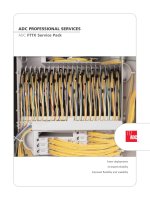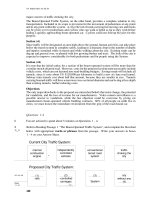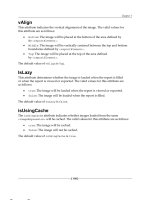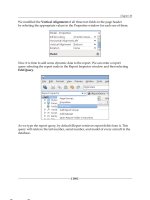Tài liệu Extreme-Environment Performance Considerations for FTTX Splitter Modules ppt
Bạn đang xem bản rút gọn của tài liệu. Xem và tải ngay bản đầy đủ của tài liệu tại đây (429.67 KB, 8 trang )
WHITE PAPER
Extreme-Environment
Performance Considerations
for FTTX Splitter Modules
Considerations for
FTTX Splitter Modules
Extreme-Environment Performance
Optical splitter modules used in FTTX networks contain the splitters that make
passive optical networks possible. The module physically protects the splitter
and provides a means to connectorize the splitter inputs and outputs.
A housing, constructed of plastic or metal, holds the splitter and provides
a means to up-jacket the splitter fibers with 2mm furcation tube for
connectorization. A certain number of outputs are connectorized. The
input fiber may be connectorized, can be a pigtail, or can be attached
to the module by means of a backplane.
Figure 1: Typical FTTX Splitter Module
Module housing
(1xN splitter inside)
Bending Strain Relief
Input
Connectors
2 mm Furcation tube
Page 3
Industry Standards
Telcordia GR-1209 and GR-1221 standards define the
operating requirements for splitter modules in North
America. GR-1209 defines basic optical performance
requirements such as insertion and return loss,
polarization-dependent loss (PDL), and uniformity.
GR-1209 also defines short-term environmental and
mechanical requirements such as input and output
proof strength and side loading, and a temperature
and humidity profile. GR-1221 defines the splitter
modules’ long-term reliability requirements. GR-1221
requires splitters to go through 2,000 hours of high
temperature aging, low-temperature aging, thermal
cycling, and humidity aging. GR-1221 also subjects
samples to impact and vibration testing.
The operating extremes defined in GR-1209 and
GR-1221 are –40°C to +85°C and up to 95% relative
humidity. GR-1209 and GR-1221 will typically be called
out by North American service providers deploying
passive optical networks. Some service providers may
require their network to function at lower temperatures.
In these cases, military specifications (MIL SPECs)
requiring –55°C minimum operating temperatures
may be called out.
These operating extremes present challenges when
designing splitter modules. Before large-scale North
American deployment of FTTx in 2004, most modules
containing splitters and connectors were used in central
offices. Splitter modules saw stable environments and
were therefore not extensively tested. Testing to extreme
conditions and deployment in outside plant environments
forced service providers and equipment manufacturers
to re-evaluate the requirements of splitter modules.
GR-1209 and GR-1221 do not consider many
characteristics that are important for devices deployed
in the OSP. For example, GR-1209 and GR-1221 do not
define material properties such as chemical resistance
or installation considerations such as the handling of
furcation tubes at extreme temperatures.
Furcation Tubing
Furcation tubing is the material slipped over the splitter
inputs and outputs. The furcation tube protects the
fiber from physical damage and makes connectorization
possible. The furcation tube is usually identical in
construction to a 2mm simplex jumper, but the .900mm
tight buffered fiber is replaced by a hollow tube. The
hollow tube has a .900mm outside diameter and the
inside diameter is larger so that a fiber can be inserted.
Once the fiber is inserted into the inner tube, a
connector can be terminated to the ends.
2mm simplex jumpers are typically used in controlled
environments. They are not required to meet the more
stringent requirements for outside deployment. It would
be risky to choose a furcation tube made out of materials
used for controlled environment jumpers that are only
rated to -20°C. Some specific requirements of furcation
tubing that aren’t explicitly called out in GR-1209 or
GR-1221 include cold-temperature handling and cable
routing, and thermal expansion and contraction.
Extreme-Environment Performance Considerations of FTTX Splitter Modules
2 mm Outer Jacket
Inner .900 mm Tube
Aramid Strength
Members
Splitter Input and
Output Fibers
Inserted Into This Space
Figure 2: Furcation Tube Construction
Extreme-Environment Performance Considerations of FTTX Splitter Modules
Page 4
Cold-temperature handling and cable routing:
The outer 2mm jacketing of furcation tube is made of
thermoplastic materials. The tubing can become very
stiff at cold temperatures. This is no issue in a static
situation. However, if new service is turned on at cold
temperatures, a technician will have to re-route the
up-jacketed splitter outputs in the fiber distribution hub
(FDH). If the furcation tube is too stiff because of the cold
temperature, routing becomes difficult and bending can
occur, causing high insertion loss.
Standard jumper jacketing materials such as PVC
become very stiff at temperatures lower than –20°C.
Proper design requires that furcation tubes be made
of different materials. Polyurethane is one possible
choice for the outer jacket. This material remains
relatively flexible to temperatures as low as –60°C and
is resistant to fungus and chemicals commonly used in
telecommunications. Some types of PVC outer jacketing
can also become permanently stiff if exposed to high
temperatures for extended periods of time. As the
PVC ages, plasticizers in the cable degrade causing the
jacket to stiffen. Polyurethane is also resistant to this
phenomenon, making it suitable for both very hot and
extremely cold environments.
Cold-temperature handling of furcation tube can be
evaluated several ways. First, the furcation tube should
be tested to FOTP-104 (Fiber Optical Cable Cyclic Flexing
Test), but performed at -40°C. It could also be tested to
FOTP-37 (Low or High Temperature Bend Test for Fiber
Optic Cable). There should be no evidence of cracking of
the outer jacket after the tests are completed. Second,
the ability to re-route furcation tube within a cable
management system must be evaluated. There are no
existing industry standards to evaluate this property.
However, this property can still be subjectively tested by
simulating cable routing at cold temperatures.
A test was performed where furcation tube made of PVC
and polyurethane were wrapped around a small mandrel
and aged at -40°C for 2 hours (see Figure 3). The
mandrel was removed and the cables were allowed to
uncoil themselves using only the weight of the connector
(see Figure 4). The polyurethane furcation tube was much
more flexible at -40°C than PVC. This property makes
polyurethane an ideal choice for furcation tube jacketing
because bending losses are less likely to occur when an
installation take place at cold temperatures.
Figure 3: Test sample on Mandrel at -40°C
Figure 4: PVC and Polyurethane Tubes at -40°C
PVC
Polyurethane
Extreme-Environment Performance Considerations of FTTX Splitter Modules
Page 5
Thermal expansion and contraction
All furcation tubes are made of thermoplastics. Plastics
tend to expand at high temperatures and contract at
low temperatures. However, the optical fiber will remain
the same length over these temperature extremes. If the
expansion and contraction of the plastic materials over
the fiber are not accounted for, fiber bending and high
insertion loss could occur.
Thermal affects usually cause insertion losses problems
at cold temperatures. Plastics contract while fibers
remain the same length at low temperatures. If the
fiber within the .900mm inner tube of the furcation
tube is bound within, bending will occur because the
fiber will buckle within the inner diameter (ID) of the
tube (shown in figure 5), causing high insertion losses
(1550 nm and 1625nm).
There are several methods to deal with this issue. The
first is to use plastics that do not contract at –40°C.
Such materials include polytetrafluoroethylene (PTFE).
Unfortunately, PTFE is very expensive and doesn’t bond
well to the epoxy in a connector, and is therefore not the
best choice. Other less expensive materials more suitable
for connectorization, such as polyvinylidene difluoride
(PVDF) or Hytrel
®1
, contract only 0.5% to 0.9% at –40°C.
Figure 6 shows expansion and contraction data for
various tube materials. Even this small amount of change
in the tubing can cause the fiber to bend. One can
compensate for this slight contraction by freeing one end
of the fiber from the tube and providing a space for the
fiber to expand into as the .900mm inner tube contracts.
An example of such a design is shown in figure 7.
Bending at cold temperatures can be avoided by letting
the far end of the fiber float freely with respect to the
tube. As the tube contracts, the fiber will push into the
“expansion chamber” where it has sufficient room to
move and not violate bend radii. Such a design prevents
bending losses in environments as cold as –60°C and
allows for a variety of plastic materials to be used for the
.900mm inner tube.
.900 mm tube
.900 mm tube
Input or output fiber at room temperature
Connector
Connector
Input or output fiber at -40°C
Figure 5: Tube Contraction Illustration
Figure 7: Expansion Chamber Concept
84
15
36
38
38
32
26
80
82
26
34
14
38
1.00%
0.90%
0.80%
0.70%
0.60%
0.50%
0.40%
0.30%
0.20%
0.10%
0.00%
-0.10%
-0.20%
-0.30%
-0.40%
-0.50%
-0.60%
-0.70%
-0.80%
-0.90%
-1.00%
Temperature vs. Length
Temperature
Percent change in Length
LCP-Filled PVDF
Hytrel
PTFE
PVDF
Figure 6: Length Data for Various .900mm Tube Materials
1
Hytrel is a registered trademark of E.I. du Pont de Nemours
and Company









